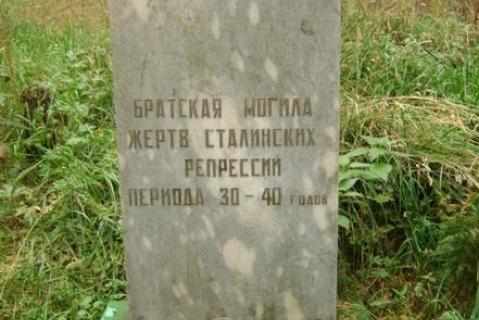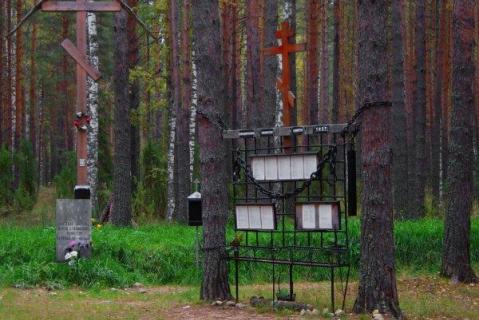In 1937-1938 NKVD “special site No. 6” was located on the territory of the Forestry Concern. It was one place where those shot in Yoshkar-Ola during the Great Terror were buried. There is information that executions took place there in August 1937, the very beginning of the terror. Local inhabitants knew about the shooting and the burials.
In 1989 the site was located thanks to the testimony of eyewitnesses. The Mari Memorial Society estimates that the site contains about 60 trenches, but the total numbers buried have not been established. Thanks to the efforts of the Mari Memorial society an official commission was set up in 1990 and this led to investigation of the site and the exhumation of the remains of 164 people from a single common grave. After forensic examination the prosecutor’s office was able to confirm the names of those shot and the date of their execution, 5-8 August 1937. The remains were reburied on 6 September 1990.
This date is considered the day on which the memorial was opened. A marble headstone was placed over the burial with the following inscription: “The common grave of the victims of Stalinist repression, 1930s-1940s”. In 2004 members of the Mari Memorial society reorganised the common graves, the reburials and the trenches. Two wooden commemorative crosses were erected, a granite boulder and an information board that read, “The memorial cemetery of the victims of Stalinist repression in the 1930s and 1940. A monument to the history of the Mari ASSR”.
In 2005 expert examination confirmed that among the remains lay Archpriest Sergy (Strelnikov), incumbent of the Orshan church, whom the Russian Orthodox Church canonised as a saint that year. After further examination in 2007 his remains were reburied.
*
According to the Unified Register, by 2023 the site had been granted protection, and upgraded status to Republican/Regional significance.
The Tragedy of the Nation: A Book in Remembrance of the Victims of Political Repression in the Republic of Mari El (3 vols. 1996-2004) contained 8,900 biographical entries of those shot or sent to the Gulag.
The Memorial online database (2025) lists 10,098 victims in Mari-El (BR 8,915), most of whom were born there (6,855).
1,462 were shot, the majority arrested during the Great Terror (1,309); over 5,000 were held in the camps; 825, most born in the Mari El ASSR, were arrested in the early 1930s and sent out of the Republic. Just under 1,200 other names were added from police records: 651 expelled as “kulaks”, 514 later for their “nationality” (most either Germans or Crimean Tatars).
| State of burials | Area | Boundaries |
|---|---|---|
|
Characteristic subsidence over trenches. The reburial is in good condition
|
About 2 hectares
|
borders of two trenches have been outlined
|
[ original texts and hyperlinks ]
K.N. Sanukov, From the history of Mari-El: The tragedy of the 1930s, Yoshkar-Ola, 2000
V.M. Yantemir, The Mendurskaya Road, a historical chronicle, Yoshkar-Ola, 2008
S.A. Krasilnikov, The Sickle and the Monster: Peasant exile in West Siberia during the 1930s, Moscow, 2009 (334 pp)
“The Mendurskoe memorial cemetery”, Virtual Museum of the Gulag [retrieved, 26 May 2022; no longer accessible]
*
Reply by Medvevevsky district administration of the Mari El Republic (No 1493 of 21 May 2014) to a formal enquiry from RIC Memorial (St Petersburg)
Reply by Mari El Republic ministry for culture, the press, and ethnic affairs (No 2792 of 07 May 2014) to a formal enquiry from RIC Memorial (St Petersburg)



